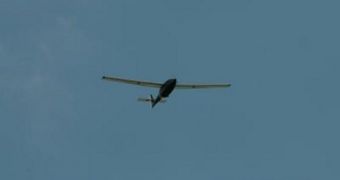Between November 16 and 17, the Ion Tiger managed to fly for 26 straight hours carrying a 5-pound (2.5-kilogram) payload, and setting a new, unofficial record. The small unmanned air vehicle (UAV) uses hydrogen fuel cells for power, and appears to be making good use of them too. The advanced aircraft was designed and constructed by experts at the Naval Research Laboratory (NRL), who say that the new test flight exceeded even their wildest expectations.
The advanced fuel cell system that powers up the Ion Tiger has been developed by a NRL-led team that also includes scientists from Protonex Technology Corporation, HyperComp Engineering, and Arcturus UAV. Funding for the research&development stage of the project came from the Office of Naval Research, which is highly interested in the amazing capabilities that the aircraft has to offer. Having the ability to deploy autonomous UAV over enemy territory, and spy on them with reduced noise levels could prove to be the decisive factor in an open confrontation.
The new flight test comes on the heels of another one, carried out between October 9 and 10, which saw the Ion Tiger fly for 23 hours and 17 minutes. With the recent achievement, the feasibility of the PEM (Proton-Exchange Membrane) fuel cells has been ultimately demonstrated. These devices make use of a special polymer electrolyte membrane, which allows them to operate at lower temperature / pressure ranges, of between 50 and 100 degrees Celsius. The PEM cells that currently power up the Ion Tiger are able to develop no less than 550 Watts (0.75 horsepower).
The aircraft in itself weighs no more than 37 pounds (about 18 kilograms), but is able to carry 4 to 5 pounds of payload. Needless to say, this cargo capacity could be used to install surveillance equipment, or laser-designating equipment. The NRL team is currently working on increasing the tactical capabilities of the plane by boosting its power to about 1.5 kW, or 2 horsepower. The goal is to get the plane to fly on its own for at least three days, at the same time ensuring that the Ion Tiger is able to power up any electronic payload it may be carrying as well.

 14 DAY TRIAL //
14 DAY TRIAL //